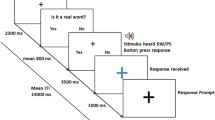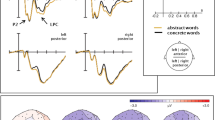Abstract
We examined ERP responses during the generation of word associates or mental images in response to concrete and abstract concepts. Of interest were the predictions of dual coding theory (DCT), which proposes that processing lexical concepts depends on functionally independent but interconnected verbal and nonverbal systems. ERP responses were time-locked to either stimulus onset or response to compensate for potential latency differences across conditions. During word associate generation, but not mental imagery, concrete items elicited a greater N400 than abstract items. A concreteness effect emerged at a later time point during the mental imagery task. Data were also analyzed using time–frequency analysis that investigated synchronization of neuronal populations over time during processing. Concrete words elicited an enhanced late going desynchronization of theta-band power (723–938 ms post stimulus onset) during associate generation. During mental imagery, abstract items elicited greater delta-band power from 800 to 1,000 ms following stimulus onset, theta-band power from 350 to 205 ms before response, and alpha-band power from 900 to 800 ms before response. Overall, the findings support DCT in suggesting that lexical concepts are not amodal and that concreteness effects are modulated by tasks that focus participants on verbal versus nonverbal, imagery-based knowledge.




Similar content being viewed by others
References
Barsalou LW, Wiemer-Hastings K (2005) Situating abstract concepts. In: Pecher D, Zwaan R (eds) Grounding cognition: the role of perception and action in memory, language, and thought. Cambridge University Press, Cambridge, England, pp 129–163
Basar E, Basar-Eroglu C, Parnefjord R, Rahn E, Schurmann M (1992) Evoked potentials: ensembles of brain induced rhythmicities in the alpha, theta and gamma ranges. In: Basar E, Bullock TH (eds) Induced rhythms in the brain. Birkhauser, Boston, pp 155–181
Bastiaansen MC, van Berkum JJ, Hagoort P (2002) Event-related theta power increases in the human EEG during online sentence processing. Neurosci Lett 323:13–16
Bastiaansen MC, van der Linden M, Ter Keurs M, Dijkstra T, Hagoort P (2005) Theta responses are involved in lexical-semantic retrieval during language processing. J Cogn Neurosci 17:530–541
Bastiaansen MC, Oostenveld R, Jensen O, Hagoort P (2008) I see what you mean: theta power increases are involved in the retrieval of lexical semantic information. Brain Lang 106:15–28
Cooper NR, Croft RJ, Dominey SJ, Burgess AP, Gruzelier JH (2003) Paradox lost? Exploring the role of alpha oscillations during externally vs. internally directed attention and the implications for idling and inhibition hypotheses. Int J Psychophysiol 47:65–74
Delorme A, Makeig S (2004) EEGLAB: an open source toolbox for analysis of single-trial EEG dynamics including independent component analysis. J Neurosci Methods 134:9–21
Dhond RP, Witzel T, Dale AM, Halgren E (2007) Spatiotemporal cortical dynamics underlying abstract and concrete word reading. Hum Brain Mapp 28:355–362
Ernest CH, Paivio A (1971) Imagery and verbal associative latencies as a function of imagery ability. Can J Psychol 25:83–90
Goldberg RF, Perfetti CA, Schneider W (2006) Perceptual knowledge retrieval activates sensory brain regions. J Neurosci 26:4917–4921
Harmony T, Fernandez T, Silva J, Bernal J, Diaz-Comas L, Reyes A, Marosi E, Rodriguez M (1996) EEG delta activity: an indicator of attention to internal processing during performance of mental tasks. Int J Psychophysiol 24:161–171
Holcomb PJ, Kounios J, Anderson JE, West WC (1999) Dual-coding, context-availability, and concreteness effects in sentence comprehension: an electrophysiological investigation. J Exp Psychol Learn Mem Cogn 25:721–742
Kounios J, Holcomb PJ (1994) Concreteness effects in semantic priming: ERP evidence supporting dual-coding theory. J Exp Psychol Learn Mem Cogn 20:804–823
Kucera H, Francis WN (1967) Computational analysis of present-day American English. Brown University Press, Providence, RI
Lehmann D, Skrandies W (1980) Reference-free identification of components of checkerboard-evoked multichannel potential fields. Electroencephalogr Clin Neurophysiol 48:609–621
Martin A (2007) The representation of object concepts in the brain. Annu Rev Psychol 58:25–45
Medler DA, Binder JR (2005) MCWord: an on-line orthographic database of the English language. In: http://www.neuro.mcw.edu/mcword/
Nelson DL, McEvoy CL, Schreiber TA (1998) The University of South Florida word association, rhyme, and word fragment norms. In: http://www.usf.edu/FreeAssociation
Nittono H, Suehiro M, Hori T (2002) Word imageability and N400 in an incidental memory paradigm. Int J Psychophysiol 44:219–229
Paivio A (1971) Imagery and verbal processes. Holt, Rinehart, and Winston, New York
Paivio A (2007) Mind and its evolution: a dual coding theoretical approach. Erlbaum, Mahwah, NJ
Petsche H, Kaplan S, von Stein A, Filz O (1997) The possible meaning of the upper and lower alpha frequency ranges for cognitive and creative tasks. Int J Psychophysiol 26:77–97
Pylyshyn ZW (1984) Computation and cognition: toward a foundation for cognitive science. MIT Press, Cambridge, MA
Schwanenflugel PJ (1991) Why are abstract concepts hard to understand? In: Schwanenflugel PJ (ed) The psychology of word meaning. Erlbaum, Mahwah, NJ
Schwanenflugel PJ, Stowe RW (1989) Context availability and the processing of abstract and concrete words in sentences. Read Res Q 24:114–126
Schwanenflugel PJ, Harnishfeger KK, Stowe RW (1988) Context availability and lexical decisions for abstract and concrete words. J Memory Lang 27:499–520
Simmons WK, Hamann SB, Harenski CL, Hu XP, Barsalou LW (2008) fMRI evidence for word association and situated simulation in conceptual processing. J Physiol Paris 102:106–119
Tyler LK, Moss HE (2001) Towards a distributed account of conceptual knowledge. Trends Cogn Sci 5:244–252
von Stein A, Sarnthein J (2000) Different frequencies for different scales of cortical integration: from local gamma to long range alpha/theta synchronization. Int J Psychophysiol 38:301–313
Weiss S, Rappelsberger P (1998) Left frontal EEG coherence reflects modality independent language processes. Brain Topogr 11:33–42
West WC, Holcomb PJ (2000) Imaginal, semantic, and surface-level processing of concrete and abstract words: an electrophysiological investigation. J Cogn Neurosci 12:1024–1037
Wilson MD (1988) The MRC Psycholingusitic Database: machine readable dictionary, version 2. Behav Res Methods Instrum Comput 20:6–11
Acknowledgments
This research was supported by a CIHR operating grant to MFJ, Natural Sciences and Engineering Research Council (Canada) Discovery Grant 0155704 to KM, and National Institute of Health Grant HD053136 to KM. Infrastructure support was provided by the Canada Foundation for Innovation and the Ontario Innovation Trust.
Author information
Authors and Affiliations
Corresponding author
Rights and permissions
About this article
Cite this article
Welcome, S.E., Paivio, A., McRae, K. et al. An electrophysiological study of task demands on concreteness effects: evidence for dual coding theory. Exp Brain Res 212, 347–358 (2011). https://doi.org/10.1007/s00221-011-2734-8
Received:
Accepted:
Published:
Issue Date:
DOI: https://doi.org/10.1007/s00221-011-2734-8




